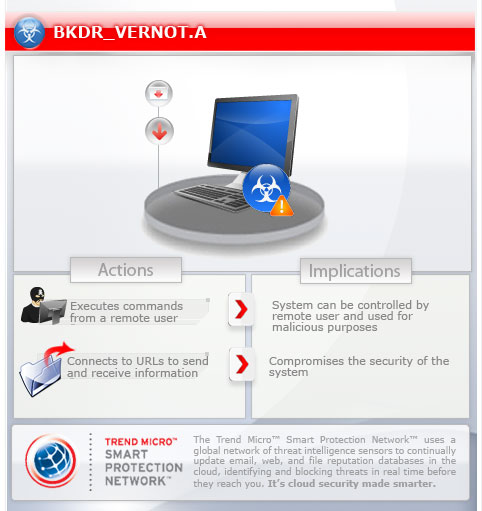BKDR_VERNOT.A
Trojan:Win32/AgentBypass.gen!G (Microsoft)
Windows 2000, Windows Server 2003, Windows XP (32-bit, 64-bit), Windows Vista (32-bit, 64-bit), Windows 7 (32-bit, 64-bit)


Threat Type: Backdoor
Destructiveness: No
Encrypted: No
In the wild: Yes
OVERVIEW
This malware connects to Evernote to receive and perform commands from remote malicious users. Users affected by this malware may find the security of their systems compromised.
To get a one-glance comprehensive view of the behavior of this Backdoor, refer to the Threat Diagram shown below.

This backdoor arrives on a system as a file dropped by other malware or as a file downloaded unknowingly by users when visiting malicious sites.
It executes commands from a remote malicious user, effectively compromising the affected system.
TECHNICAL DETAILS
Arrival Details
This backdoor arrives on a system as a file dropped by other malware or as a file downloaded unknowingly by users when visiting malicious sites.
Installation
This backdoor drops the following file(s)/component(s):
- %User Temp%\NETUT.dll - Also detected as BKDR_VERNOT.A
(Note: %User Temp% is the current user's Temp folder, which is usually C:\Documents and Settings\{user name}\Local Settings\Temp on Windows 2000, XP, and Server 2003, or C:\Users\{user name}\AppData\Local\Temp on Windows Vista and 7.)
Its DLL component is injected to the following process(es):
- explorer.exe
Autostart Technique
This backdoor modifies the following registry entries to ensure it automatic execution at every system startup:
HKEY_CURRENT_USER\Software\Microsoft\
Windows NT\CurrentVersion\Windows
load = "{Malware path and file name}.exe"
(Note: The default value data of the said registry entry is "" .)
Backdoor Routine
This backdoor executes the following commands from a remote malicious user:
- Download files
- Execute files
- Rename files
- Unzip archive files
Information Theft
This backdoor gathers the following data:
- Affected machine’s Registered Owner
- Affected machine’s Registered Organization
- Affected machine's OS information
- Affected machine's Time Zone
- Affected machine's User Name
- Affected machine's Computer Name
NOTES:
It connects to the legitimate site Evernote, a site designed for notetaking and archiving. It does this by connecting to this URL:
- https://evernote.com/intl/zh-cn
Since the user credentials used by BKDR_VERNOT.A to login to its Evernote account have already expired, it was not able to perform its backdoor routines.
It is possible that BKDR_VERNOT.A retrieves its C&C server in one of the notes saved in its Evernote account. It is also possible that it queries its backdoor commands in the notes saved in its Evernote account. It is also possible that BKDR_VERNOT.A uses the notes as a drop-off point for the stolen information.
SOLUTION
Step 1
Before doing any scans, Windows XP, Windows Vista, and Windows 7 users must disable System Restore to allow full scanning of their computers.
Step 2
Scan your computer with your Trend Micro product and note files detected as BKDR_VERNOT.A
Step 3
Restart in Safe Mode
Step 4
Restore this modified registry value
Important: Editing the Windows Registry incorrectly can lead to irreversible system malfunction. Please do this step only if you know how or you can ask assistance from your system administrator. Else, check this Microsoft article first before modifying your computer's registry.
- In HKEY_CURRENT_USER\Software\Microsoft\Windows NT\CurrentVersion\Windows
- From: load = "{Malware path and file name}.exe"
To: load = ""
- From: load = "{Malware path and file name}.exe"
Step 5
Search and delete the files detected as BKDR_VERNOT.A
*Note: Some component files may be hidden. Please make sure you check the Search Hidden Files and Folders checkbox in the More advanced options option to include all hidden files and folders in the search result.
To stop the malware/grayware from running when certain files are opened:
For Windows 2000, Windows XP, and Windows Server 2003:
- Right-click Start then click Search....
- In the Named input box, type the name of the file that was detected earlier.
- In the Look In drop-down list, select My Computer then press Enter.
- Once located, select the file then press SHIFT+DELETE to delete it.
For Windows Vista and Windows 7:
- Click Start>Computer.
- In the Search Computer input box, type the name of the file detected earlier, and press Enter.
- Once located, select the file then press SHIFT+DELETE to delete it.
*Note: Read the following Microsoft page if these steps do not work on Windows 7.
Step 6
Restart in normal mode and scan your computer with your Trend Micro product for files detected as BKDR_VERNOT.A. If the detected files have already been cleaned, deleted, or quarantined by your Trend Micro product, no further step is required. You may opt to simply delete the quarantined files. Please check this Knowledge Base page for more information.
Did this description help? Tell us how we did.

